2014 NISSAN CUBE headrest
[x] Cancel search: headrestPage 20 of 332
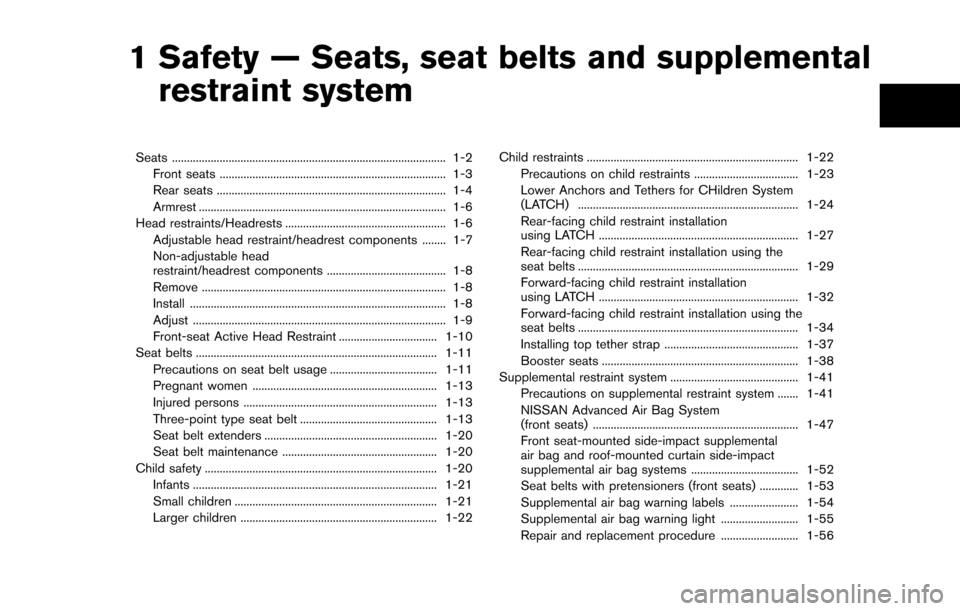
1 Safety — Seats, seat belts and supplementalrestraint system
Seats ........................................................................\
.................... 1-2
Front seats ........................................................................\
.... 1-3
Rear seats ........................................................................\
..... 1-4
Armrest ........................................................................\
........... 1-6
Head restraints/Headrests ...................................................... 1-6 Adjustable head restraint/headrest components ........ 1-7
Non-adjustable head
restraint/headrest components ........................................ 1-8
Remove ........................................................................\
.......... 1-8
Install ........................................................................\
.............. 1-8
Adjust ........................................................................\
............. 1-9
Front-seat Active Head Restraint ................................. 1-10
Seat belts ........................................................................\
......... 1-11
Precautions on seat belt usage .................................... 1-11
Pregnant women .............................................................. 1-13
Injured persons ................................................................. 1-13
Three-point type seat belt .............................................. 1-13
Seat belt extenders .......................................................... 1-20
Seat belt maintenance .................................................... 1-20
Child safety ........................................................................\
...... 1-20 Infants ........................................................................\
.......... 1-21
Small children .................................................................... 1-21
Larger children .................................................................. 1-22 Child restraints ....................................................................... 1-22
Precautions on child restraints ................................... 1-23
Lower Anchors and Tethers for CHildren System
(LATCH) ........................................................................\
.. 1-24
Rear-facing child restraint installation
using LATCH ................................................................... 1-27
Rear-facing child restraint installation using the
seat belts ........................................................................\
.. 1-29
Forward-facing child restraint installation
using LATCH ................................................................... 1-32
Forward-facing child restraint installation using the
seat belts ........................................................................\
.. 1-34
Installing top tether strap ............................................. 1-37
Booster seats .................................................................. 1-38
Supplemental restraint system ........................................... 1-41 Precautions on supplemental restraint system ....... 1-41
NISSAN Advanced Air Bag System
(front seats) ..................................................................... 1-47
Front seat-mounted side-impact supplemental
air bag and roof-mounted curtain side-impact
supplemental air bag systems .................................... 1-52
Seat belts with pretensioners (front seats) ............. 1-53
Supplemental air bag warning labels ....................... 1-54
Supplemental air bag warning light .......................... 1-55
Repair and replacement procedure .......................... 1-56
Page 25 of 332
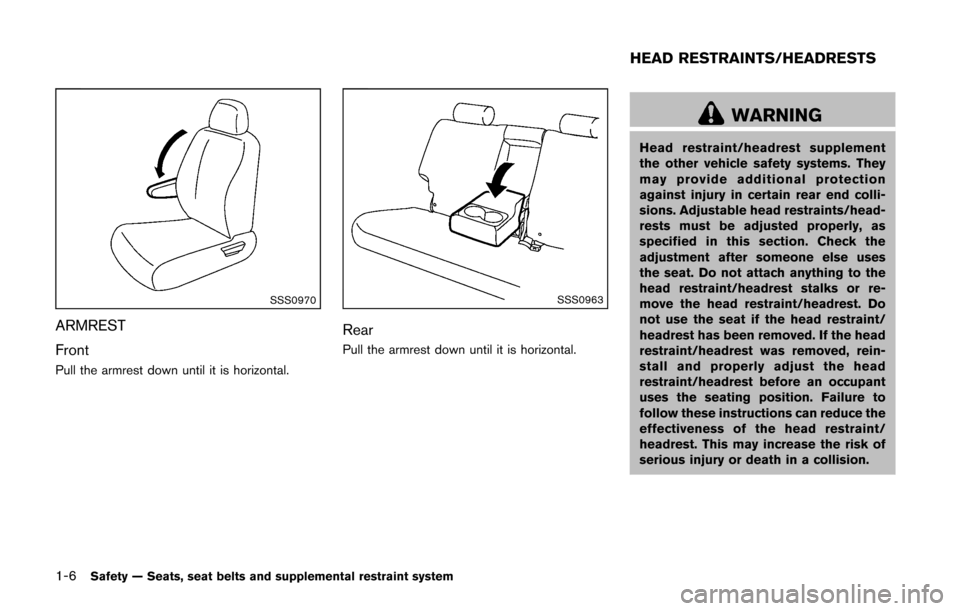
1-6Safety — Seats, seat belts and supplemental restraint system
SSS0970
ARMREST
Front
Pull the armrest down until it is horizontal.
SSS0963
Rear
Pull the armrest down until it is horizontal.
WARNING
Head restraint/headrest supplement
the other vehicle safety systems. They
may provide additional protection
against injury in certain rear end colli-
sions. Adjustable head restraints/head-
rests must be adjusted properly, as
specified in this section. Check the
adjustment after someone else uses
the seat. Do not attach anything to the
head restraint/headrest stalks or re-
move the head restraint/headrest. Do
not use the seat if the head restraint/
headrest has been removed. If the head
restraint/headrest was removed, rein-
stall and properly adjust the head
restraint/headrest before an occupant
uses the seating position. Failure to
follow these instructions can reduce the
effectiveness of the head restraint/
headrest. This may increase the risk of
serious injury or death in a collision.
HEAD RESTRAINTS/HEADRESTS
Page 26 of 332
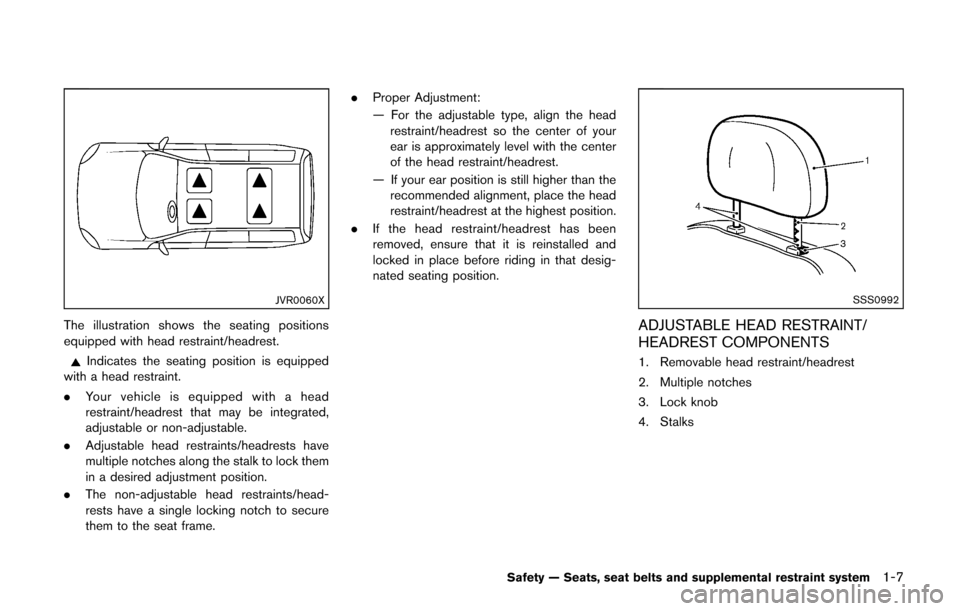
JVR0060X
The illustration shows the seating positions
equipped with head restraint/headrest.
Indicates the seating position is equipped
with a head restraint.
. Your vehicle is equipped with a head
restraint/headrest that may be integrated,
adjustable or non-adjustable.
. Adjustable head restraints/headrests have
multiple notches along the stalk to lock them
in a desired adjustment position.
. The non-adjustable head restraints/head-
rests have a single locking notch to secure
them to the seat frame. .
Proper Adjustment:
— For the adjustable type, align the head
restraint/headrest so the center of your
ear is approximately level with the center
of the head restraint/headrest.
— If your ear position is still higher than the recommended alignment, place the head
restraint/headrest at the highest position.
. If the head restraint/headrest has been
removed, ensure that it is reinstalled and
locked in place before riding in that desig-
nated seating position.
SSS0992
ADJUSTABLE HEAD RESTRAINT/
HEADREST COMPONENTS
1. Removable head restraint/headrest
2. Multiple notches
3. Lock knob
4. Stalks
Safety — Seats, seat belts and supplemental restraint system1-7
Page 27 of 332
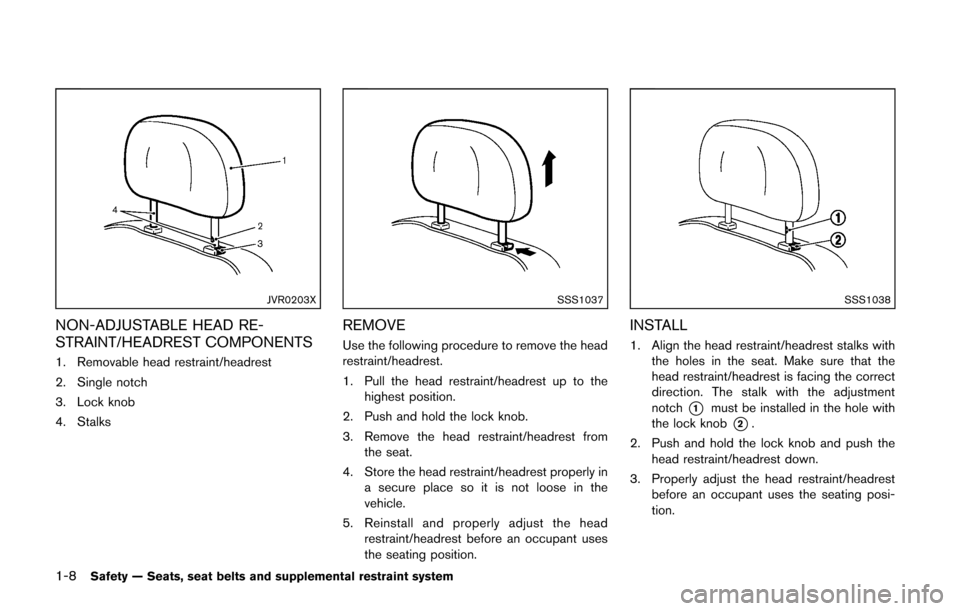
1-8Safety — Seats, seat belts and supplemental restraint system
JVR0203X
NON-ADJUSTABLE HEAD RE-
STRAINT/HEADREST COMPONENTS
1. Removable head restraint/headrest
2. Single notch
3. Lock knob
4. Stalks
SSS1037
REMOVE
Use the following procedure to remove the head
restraint/headrest.
1. Pull the head restraint/headrest up to thehighest position.
2. Push and hold the lock knob.
3. Remove the head restraint/headrest from the seat.
4. Store the head restraint/headrest properly in a secure place so it is not loose in the
vehicle.
5. Reinstall and properly adjust the head restraint/headrest before an occupant uses
the seating position.
SSS1038
INSTALL
1. Align the head restraint/headrest stalks with
the holes in the seat. Make sure that the
head restraint/headrest is facing the correct
direction. The stalk with the adjustment
notch
*1must be installed in the hole with
the lock knob
*2.
2. Push and hold the lock knob and push the head restraint/headrest down.
3. Properly adjust the head restraint/headrest before an occupant uses the seating posi-
tion.
Page 28 of 332
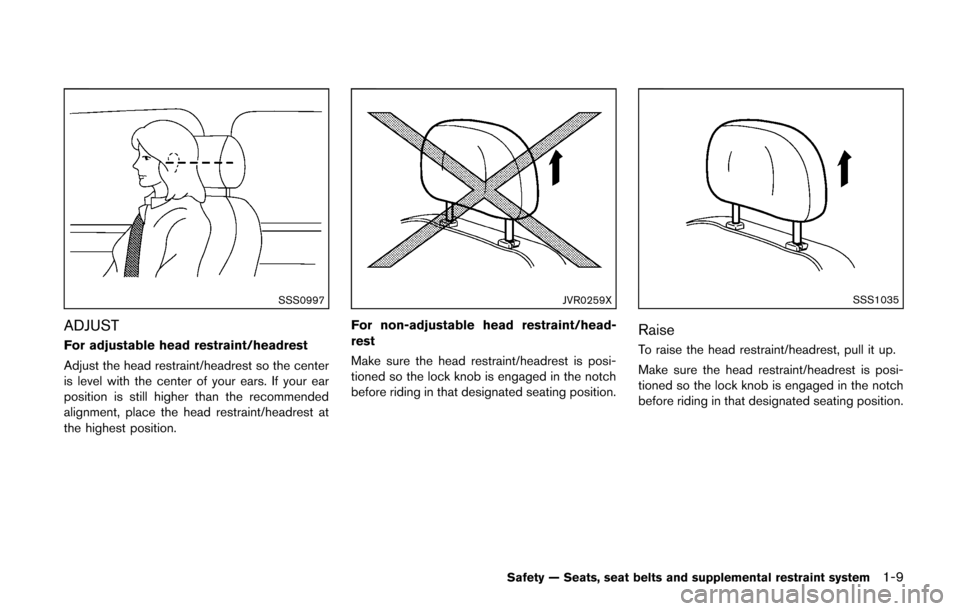
SSS0997
ADJUST
For adjustable head restraint/headrest
Adjust the head restraint/headrest so the center
is level with the center of your ears. If your ear
position is still higher than the recommended
alignment, place the head restraint/headrest at
the highest position.
JVR0259X
For non-adjustable head restraint/head-
rest
Make sure the head restraint/headrest is posi-
tioned so the lock knob is engaged in the notch
before riding in that designated seating position.
SSS1035
Raise
To raise the head restraint/headrest, pull it up.
Make sure the head restraint/headrest is posi-
tioned so the lock knob is engaged in the notch
before riding in that designated seating position.
Safety — Seats, seat belts and supplemental restraint system1-9
Page 29 of 332
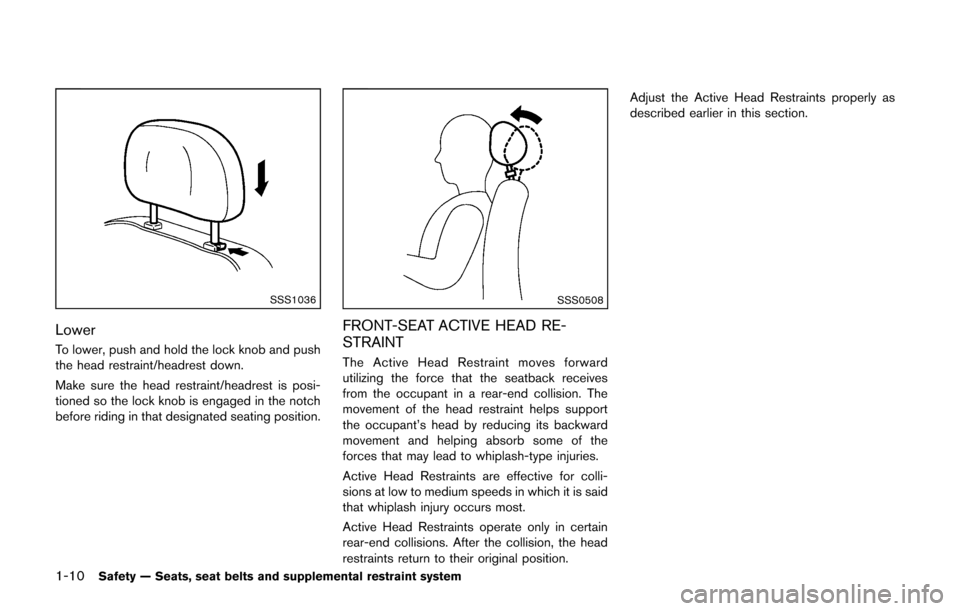
1-10Safety — Seats, seat belts and supplemental restraint system
SSS1036
Lower
To lower, push and hold the lock knob and push
the head restraint/headrest down.
Make sure the head restraint/headrest is posi-
tioned so the lock knob is engaged in the notch
before riding in that designated seating position.
SSS0508
FRONT-SEAT ACTIVE HEAD RE-
STRAINT
The Active Head Restraint moves forward
utilizing the force that the seatback receives
from the occupant in a rear-end collision. The
movement of the head restraint helps support
the occupant’s head by reducing its backward
movement and helping absorb some of the
forces that may lead to whiplash-type injuries.
Active Head Restraints are effective for colli-
sions at low to medium speeds in which it is said
that whiplash injury occurs most.
Active Head Restraints operate only in certain
rear-end collisions. After the collision, the head
restraints return to their original position.Adjust the Active Head Restraints properly as
described earlier in this section.
Page 59 of 332
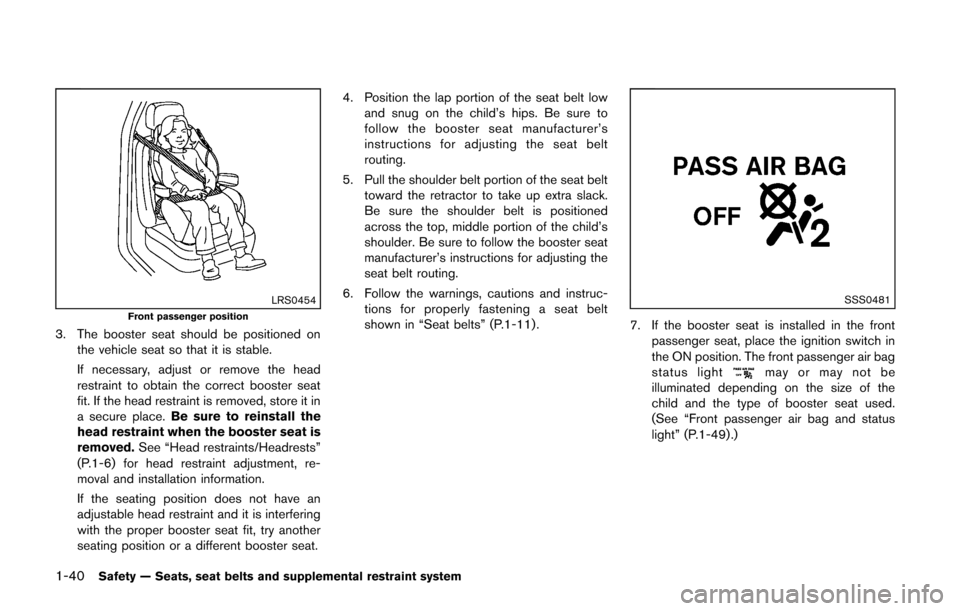
1-40Safety — Seats, seat belts and supplemental restraint system
LRS0454Front passenger position
3. The booster seat should be positioned onthe vehicle seat so that it is stable.
If necessary, adjust or remove the head
restraint to obtain the correct booster seat
fit. If the head restraint is removed, store it in
a secure place. Be sure to reinstall the
head restraint when the booster seat is
removed. See “Head restraints/Headrests”
(P.1-6) for head restraint adjustment, re-
moval and installation information.
If the seating position does not have an
adjustable head restraint and it is interfering
with the proper booster seat fit, try another
seating position or a different booster seat. 4. Position the lap portion of the seat belt low
and snug on the child’s hips. Be sure to
follow the booster seat manufacturer’s
instructions for adjusting the seat belt
routing.
5. Pull the shoulder belt portion of the seat belt toward the retractor to take up extra slack.
Be sure the shoulder belt is positioned
across the top, middle portion of the child’s
shoulder. Be sure to follow the booster seat
manufacturer’s instructions for adjusting the
seat belt routing.
6. Follow the warnings, cautions and instruc- tions for properly fastening a seat belt
shown in “Seat belts” (P.1-11) .
SSS0481
7. If the booster seat is installed in the front
passenger seat, place the ignition switch in
the ON position. The front passenger air bag
status light
may or may not be
illuminated depending on the size of the
child and the type of booster seat used.
(See “Front passenger air bag and status
light” (P.1-49).)
Page 325 of 332
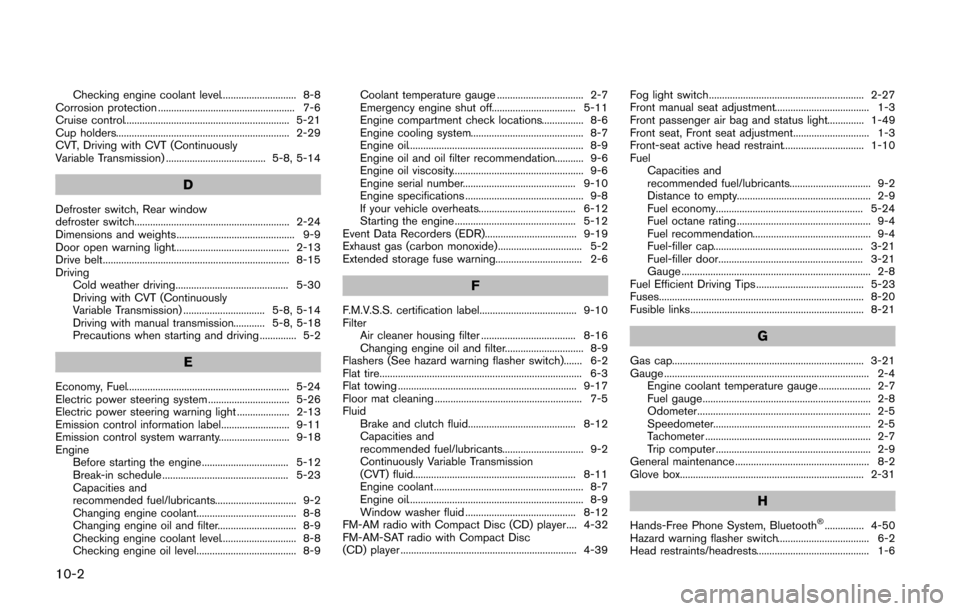
10-2
Checking engine coolant level............................. 8-8
Corrosion protection .................................................... 7-6
Cruise control............................................................... 5-21
Cup holders.................................................................. 2-29
CVT, Driving with CVT (Continuously
Variable Transmission) ...................................... 5-8, 5-14
D
Defroster switch, Rear window
defroster switch........................................................... 2-24
Dimensions and weights............................................. 9-9
Door open warning light............................................ 2-13
Drive belt....................................................................... 8-15
Driving Cold weather driving........................................... 5-30
Driving with CVT (Continuously
Variable Transmission) ............................... 5-8, 5-14
Driving with manual transmission............ 5-8, 5-18
Precautions when starting and driving .............. 5-2
E
Economy, Fuel.............................................................. 5-24
Electric power steering system ............................... 5-26
Electric power steering warning light .................... 2-13
Emission control information label.......................... 9-11
Emission control system warranty........................... 9-18
EngineBefore starting the engine................................. 5-12
Break-in schedule ................................................ 5-23
Capacities and
recommended fuel/lubricants............................... 9-2
Changing engine coolant...................................... 8-8
Changing engine oil and filter.............................. 8-9
Checking engine coolant level............................. 8-8
Checking engine oil level...................................... 8-9 Coolant temperature gauge ................................. 2-7
Emergency engine shut off................................ 5-11
Engine compartment check locations................ 8-6
Engine cooling system........................................... 8-7
Engine oil................................................................... 8-9
Engine oil and oil filter recommendation........... 9-6
Engine oil viscosity.................................................. 9-6
Engine serial number........................................... 9-10
Engine specifications ............................................. 9-8
If your vehicle overheats..................................... 6-12
Starting the engine .............................................. 5-12
Event Data Recorders (EDR)................................... 9-19
Exhaust gas (carbon monoxide)................................ 5-2
Extended storage fuse warning................................. 2-6
F
F.M.V.S.S. certification label..................................... 9-10
Filter Air cleaner housing filter .................................... 8-16
Changing engine oil and filter.............................. 8-9
Flashers (See hazard warning flasher switch)....... 6-2
Flat tire............................................................................. 6-3
Flat towing .................................................................... 9-17
Floor mat cleaning ........................................................ 7-5
Fluid Brake and clutch fluid......................................... 8-12
Capacities and
recommended fuel/lubricants............................... 9-2
Continuously Variable Transmission
(CVT) fluid.............................................................. 8-11
Engine coolant......................................................... 8-7
Engine oil................................................................... 8-9
Window washer fluid .......................................... 8-12
FM-AM radio with Compact Disc (CD) player.... 4-32
FM-AM-SAT radio with Compact Disc
(CD) player ................................................................... 4-39 Fog light switch........................................................... 2-27
Front manual seat adjustment.................................... 1-3
Front passenger air bag and status light.............. 1-49
Front seat, Front seat adjustment............................. 1-3
Front-seat active head restraint............................... 1-10
Fuel Capacities and
recommended fuel/lubricants............................... 9-2
Distance to empty................................................... 2-9
Fuel economy........................................................ 5-24
Fuel octane rating ................................................... 9-4
Fuel recommendation............................................. 9-4
Fuel-filler cap......................................................... 3-21
Fuel-filler door....................................................... 3-21
Gauge ........................................................................ 2-8
Fuel Efficient Driving Tips ......................................... 5-23
Fuses.............................................................................. 8-20
Fusible links.................................................................. 8-21
G
Gas cap......................................................................... 3-21
Gauge .............................................................................. 2-4 Engine coolant temperature gauge .................... 2-7
Fuel gauge................................................................ 2-8
Odometer.................................................................. 2-5
Speedometer............................................................ 2-5
Tachometer ............................................................... 2-7
Trip computer........................................................... 2-9
General maintenance ................................................... 8-2
Glove box...................................................................... 2-31
H
Hands-Free Phone System, Bluetooth®............... 4-50
Hazard warning flasher switch................................... 6-2
Head restraints/headrests........................................... 1-6